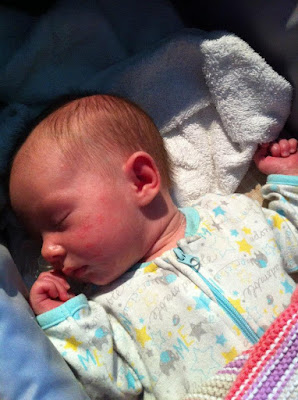Milia Seeds - What, Why and How to Get Rid Of
May 29, 2015Do you have milia seeds on your face?
No?
Lucky you. Jog on.
Milia seeds (aka oil seeds or milk spots) are small white dots or bumps that sit under the surface of your skin, often around the eyes and temples. Often mistaken for white heads/pimples, milia are actually formed from keratin (the stuff your hair and fingernails are made from) and not sebum or pus. Because that's way less gross, right?
Newborn babies often have milia which usually will go away if ignored and certainly not squeezed or tampered with in any way. My own Miss L had quite the pizza face.
In adults, milia are much harder to remove. Even though they aren't itchy, painful or harmful, they do cause a bump in the skin so chances are you're probably not thrilled about having them.
Milia are caused during your skin's natural cell-shedding process, when some cells get left behind and start clogging up the pore. Meanwhile, the sebaceous gland is still pumping away merrily, producing fluids that then become trapped in the pore. New skin grows over the gland and there you have a milia seed - trapped underneath a layer of skin and not going anywhere until that skin is removed one way or the other. Not cute.
 |
| [image credit] |
There are a few causes:
Over-use of rich oily skin products like moisturisers and eye creams which prevent the natural sloughing of dead skin cells. Switching to a lighter gel-based formula may reduce the occurence of milia. This also goes for your foundation. Obviously, regular cleansing is a must along with gentle exfoliation. Here's the thing though, milia can also be caused by OVER cleansing with harsh scrubs or chemicals so follow the appropriate directions or you may make matters worse.
Milia can also be caused by skin trauma, including sun damage. Skin thickens in response to trauma, therefore easily trapping the keratin deposits underneath and making it harder for them to be removed.
Then again, it could be thanks to good old genetics! The tendency to get milia may just be something you're born with. Unlucky.
Have you worked out yet that I get these pesky things??
 |
| #AlmostPoshKeepsItReal |
Google "milia seed removal" and you are likely to find many sources advising the only way to safely remove milia is by booking yourself in with a dermatologist. Obviously putting yourself in the hands of the professionals is the best way to go.
. . .
Of course, if you choose not to heed this advice, you can have a go at getting rid of them yourself.
Milia are easier to remove when they first form because they're softer and there's not as much skin formed over the top.
The old face sauna - head under a towel over a bowl of steaming water will open those pores right up and provide a good foundation for a thorough cleanse and exfoliate. Some people also recommend applying raw honey which has antioxidant and moisturising properties so can be used as on its own or mixed in as part of a facial scrub treatment, eg with raw sugar and oil.
You can also try a glycolic acid peel if that's how you roll.
If you're determined to have at them yourself, the Almost Posh method is to sterilise a needle, wash hands then poke the top of the milia to create an exit hole before squeezing it out. It's not an easy process, it will bleed a bit and hurt like a bastard but once it's out, it's gone! Probably best not to attempt self-removal for ones that are really close to your eye or actually on your eyelid. And obvs I'm not trained in any way, this does not constitute professional advice, if pain persists see your doctor etc.
Note that you will likely have a mark on your face for a few days after so probably best not to attempt it on the day of a special occasion.
How do you tackle milia if you have them?


0 comments